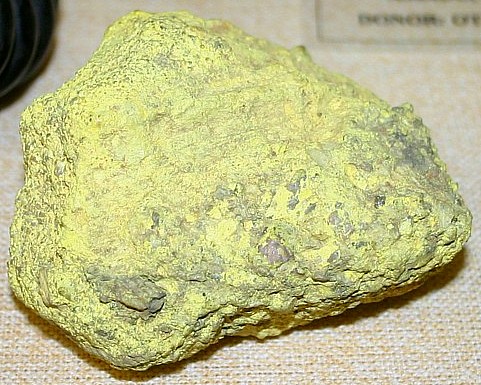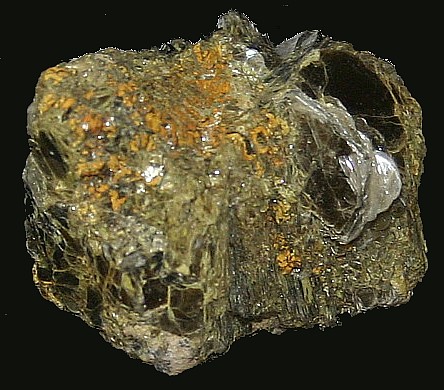Uranium, which is not found in a native metallic form, is a hard, white metal, having a specific gravity of 18.7, and melting at a white heat. It is a constituent of the rare minerals, pitchblende (uraninite) and carnotite, which form the chief sources of uranium. Metallic uranium is prepared by reduction of its oxide with carbon in the electric furnace, it is commercially of great importance in the generation of electric power by nuclear methods as well as for thermonuclear atomic weapons. For many years, pitchblende and carnotite were worked solely for their content of radium, which was used in many products. A small amount of Radium is contained in all uranium minerals. Radium salts obtained from uranium ores were once used for making objects luminous and in medicine, especially in the treatment of cancer.
Uranium forms two oxides, and from these a complex group of uranium salts is derived. The historic uses of uranium oxides as such are very limited, chiefly in glass-staining, pottery glazing and photography. There is a large market for uranium for power generation across the planet as it is well used by many countries, even though the US does not generally encourage or support nuclear power. Uranium ore minerals are valued according to their percentage of U3O8, which always carries a definite proportion of Uranium 235, the fissionable isotope. The demand for radium has long been on the decrease. The sources of uranium minerals are comparatively few. The United States are produces uranium from carnotite mined from the deposits of Colorado and Utah. Uranium is presently mined in northeastern Saskatchewan, Canada where it is extracted from the mineral thorite. Some pitchblende is obtained from Cornwall and Australia, but the principal source is the Congo, in Africa. The chief uranium minerals are Pitchblende, (uraninite), Torbernite, Autunite, and Carnotite. Uranium is also found in Samarskite, a mineral of highly variable composition; contains uranium, iron, lime, and several rare earths. In the microcosmic bead, uranium compounds give a light moss green color, both hot and cold, in the oxidizing flame.
Uranium minerals are found in veins associated with igneous rocks and disseminated in sandstone in regions where igneous activity is not prominent. Some of the uranium ores appear to have been deposited by cold water and enriched by superficial alteration. Uraninite, the crystallized form of the mineral which in its amorphous form is known as pitchblende, is found in pegmatites and other igneous rocks. Uraninite is comparatively easily attacked by weathering processes and so is almost unknown in placer deposits. Some of the best known deposits of uraninite or pitchblende are in the Erzgebirge, Bohemia and Saxony, and in Gilpin County, Colorado. In the Erzgebirge sedimentary and metamorphic rocks are intruded by granitic rocks. At Joachimsthal, Bohemia, the pitchblende ores are associated with quartz, dolomite, pyrite, and chalcopyrite.
At Quartz Hill, Gilpin County, Colorado, schists and granites are cut by Tertiary intrusive monzonite and bostonite porphyries. Mineralization occurred at two periods; in the first pyrite, quartz, tetrahedrite, rhodochrosite, and other minerals were formed; in the later period the minerals were quartz, calcite, galena, sphalerite, pyrite, and chalcopyrite. Some miners state that the pitchblende was deposited during the earlier pyrite mineralization and that it was subsequently fractured and veined with ores of the lead zinc mineralization. It also occurs in North and South Carolina, where it is found in pegmatites, largely altered to gummite and other minerals. Carnotite is found at Radium Hill, near Olary, South Australia. The country is an area of metamorphic gneisses and schists cut by dikes of granite and diorite. The carnotite occurs in a lode associated with quartz, biotite, magnetite, ilmenite, and rutile. As a yellow powder and small platy crystals it coats cracks and fills cavities. Crook and Blake believe that the gangue minerals are related to eruptive activity.
The largest deposits of uranium in the US are found in Paradox Valley, Colorado, and in eastern Utah, where carnotite uranium ore is found in fractures in Jurassic sandstone. The ores are found in the Plateau province of horizontal or gently inclined strata in southwestern Colorado and eastern Utah. The best known localities are at Placerville, Colorado, and in the La Sal, Paradox and Sindbad valleys somewhat farther west. The ores are mainly confined to the McElmo and LaPlata formations of white, often cross bedded Jurassic sandstone which frequently contain much transported partly carbonized wood. They follow certain horizons or appear in fissures of flat veins or in brecciated zones and are often associated with the fossil wood. The ore replaces calcite cement as well as the organic material in the sandstone. In general the deposits are richer near the surface than in depth, and they are believed to have been deposited by cold water and concentrated by surface agencies. A number of unusual minerals are contained in these deposits, but the most conspicuous is carnotite, a bright yellow crystalline potassium-uranium vanadate. Gypsum is about the only gangue mineral associated with the ores. The ores are not rich. The carnotite ores contain about 1.5 to 3 percent Uranium oxide and 3 to 5 percent vanadium. At Placerville the workings are said to have penetrated 2,000 feet underground in horizontal direction. In situ mining has been successfully attempted in some cases.
A vanadiferous vein which carries also a little uranium as autunite occurs l9 miles northeast of Placerville, Colo. The district contains nearly flat sedimentary rocks, cut by intrusive diorite porphyry and by basic dikes. The deposit is in a fault fissure in the Dolores formation. Near the vein the limestone wall rock is recrystallized to calcite and coated with Ankerite, chromium mica. The minerals include chalcopyrite, chalcocite, autunite, asphaltum, malachite, azurite, and molybdenite. Gold and silver are also present. Near this vein are valuable bedding plane deposits of rare metals in the overlying La Plata sandstone, which is nearly pure quartz cemented by calcite. Near the deposits the sandstone is indurated, and the calcite cement is apparently replaced by quartz. Ankerite chromium mica is deposited over extensive areas at the horizon of the vanadium ore. Secondary carnotite deposited on fractures has evidently been leached out of the vanadium ore. Ransome considers the Placerville deposits to have replaced calcite in the sandstone. Many of them are found to give out in depth or when followed into the hills by tunnels, and, because they appear to be related to the present surface, they are supposed to have been formed or enriched by superficial agencies. Some of the carnotite deposits in La Sal Creek are pockets in sandstone above a shale, and some occupy fissures or planes of movement such as might have been formed by slipping of the sandstone on the shale since the region acquired the present topography.
Since the Placerville deposits were discovered numerous occurrences of carnotite and other nearly related minerals have been developed in rocks of the same or approximately the same age, extending over a wide area in southwestern Colorado and into Utah. All the deposits appear to be in the La Plata (Jurassic?) or the McElmo (Jurassic) formation. Fossil wood and bones are nearly everywhere associated with the deposits, and the common mineral associates are copper carbonates, vanadium and chromium minerals, and some pyrite. Hess mentions a deposit in the La Sal Mountains where a petrified tree was mined for ore, the uranium being richest around the edge, or the part that was probably most decayed before burial. To account for these deposits Hess proposes a hypothesis that assumes older uranium and vanadium veins in the drainage basins that supplied the La Plata and McElmo sediments and cites several deposits as possible examples. Uranium and vanadium from these veins would be dissolved by sulphuric acid generated by pyrite and carried to the sea, where they might be precipitated by decaying reeds and trees.
Return
to Metal Ores Page:
Precious and Base Metal Ores

Above: Carnotite, an important ore of Uranium in the USA

Above: Yellow Carnotite associated with petrified wood.

Above: Uraninite or pitchblende, is a uranium oxide and is the most important ore of Uranium on a worldwide basis.
